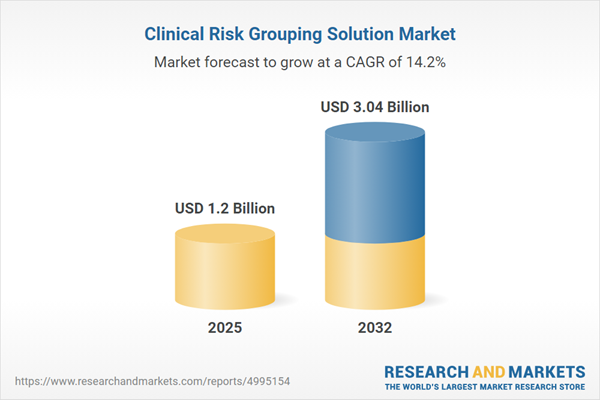Speak directly to the analyst to clarify any post sales queries you may have.
Clinical risk grouping solutions are transforming how healthcare organizations manage patient populations, optimize clinical and financial outcomes, and navigate regulatory demands. As technologies and policy frameworks evolve, these platforms are emerging as essential tools for proactive decision-making at scale.
Market Snapshot: Clinical Risk Grouping Solution Market Growth
The Clinical Risk Grouping Solution Market grew from USD 1.05 billion in 2024 to USD 1.20 billion in 2025. It is expected to continue expanding at a CAGR of 14.21%, reaching USD 3.04 billion by 2032.
Scope & Segmentation: Navigating the Clinical Risk Grouping Market
This comprehensive report covers cutting-edge technologies, strategic deployments, and diverse end users that define the clinical risk grouping landscape. Industry stakeholders gain insights into region-specific dynamics, regulatory influences, and emerging solution preferences.
- Deployment Mode: Cloud (Hybrid Cloud, Private Cloud, Public Cloud), On Premise
- Solution Type: Software and Services (including Implementation Services, Support and Maintenance), Software Only
- Payment Model: Fee For Service, Value Based Care
- Organization Size: Large Enterprises, Small and Medium Enterprises
- End User: Hospitals (Large Hospitals, Small Hospitals), Payers (Private Payers, Public Payers), Research Institutes
- Regional Coverage: Americas (United States, Canada, Mexico, Brazil, Argentina, Chile, Colombia, Peru), Europe, Middle East & Africa (United Kingdom, Germany, France, Russia, Italy, Spain, Netherlands, Sweden, Poland, Switzerland, United Arab Emirates, Saudi Arabia, Qatar, Turkey, Israel, South Africa, Nigeria, Egypt, Kenya), Asia-Pacific (China, India, Japan, Australia, South Korea, Indonesia, Thailand, Malaysia, Singapore, Taiwan)
- Key Vendors: UnitedHealth Group Incorporated, Cotiviti, Inc., 3M Company, Cognizant Technology Solutions Corporation, HMS Holdings Corp., Oracle Corporation, Health Catalyst, Inc., Allscripts Healthcare Solutions, Inc., Evolent Health, Inc., R1 RCM Inc.
Key Takeaways for Senior Decision-Makers
- Clinical risk grouping solutions enable advanced patient stratification, bridging disparate data sources for unified care management across complex healthcare networks.
- Regulatory shifts and a focus on value-based care highlight the need for accurate risk stratification and integrated analytics to drive performance improvement and cost efficiency.
- Technological innovation, including artificial intelligence and scalable architectures, drives real-time insights and accelerates proactive risk mitigation.
- Cloud deployment models gain traction for cost management and scalability, especially as organizations adapt to increasing regulatory and cost pressures.
- Regional dynamics and policy variances require local adaptation of solutions, ensuring adherence to data governance requirements and maximizing alignment with market needs.
- Strategic partnerships and co-innovation among providers, payers, and technology vendors are influencing both product development and market adoption trajectories.
Tariff Impact: Addressing Regulatory Changes
New U.S. tariff regulations for 2025 are affecting hardware and infrastructure costs associated with clinical risk grouping platforms. These cost pressures prompt a critical evaluation of on-premise versus cloud deployments, often accelerating cloud migration and supplier diversification. Vendors are responding with flexible sourcing models and regional manufacturing to maintain competitive pricing and reliability.
Methodology & Data Sources
Research methodology integrates in-depth secondary research, expert interviews, and robust data triangulation using diverse healthcare sources and technology benchmarks. Quality assurance involved independent peer reviews and iterative validation to ensure factual accuracy and market relevance.
Why This Report Matters
- Enables hospital executives, payers, and technology leaders to align investments with current trends in risk stratification and data-driven healthcare transformation.
- Provides actionable intelligence to navigate shifting regulatory requirements and leverage critical industry partnerships for operational excellence and competitive differentiation.
Conclusion
This report offers a clear roadmap for deploying clinical risk grouping solutions in a changing healthcare environment. With actionable insights grounded in rigorous research, stakeholders are equipped to maximize value and accelerate transformation in patient care delivery.
Additional Product Information:
- Purchase of this report includes 1 year online access with quarterly updates.
- This report can be updated on request. Please contact our Customer Experience team using the Ask a Question widget on our website.
Table of Contents
3. Executive Summary
4. Market Overview
7. Cumulative Impact of Artificial Intelligence 2025
Companies Mentioned
The companies profiled in this Clinical Risk Grouping Solution market report include:- UnitedHealth Group Incorporated
- Cotiviti, Inc.
- 3M Company
- Cognizant Technology Solutions Corporation
- HMS Holdings Corp.
- Oracle Corporation
- Health Catalyst, Inc.
- Allscripts Healthcare Solutions, Inc.
- Evolent Health, Inc.
- R1 RCM Inc.
Table Information
| Report Attribute | Details |
|---|---|
| No. of Pages | 196 |
| Published | October 2025 |
| Forecast Period | 2025 - 2032 |
| Estimated Market Value ( USD | $ 1.2 Billion |
| Forecasted Market Value ( USD | $ 3.04 Billion |
| Compound Annual Growth Rate | 14.2% |
| Regions Covered | Global |
| No. of Companies Mentioned | 11 |









